steering FIAT PALIO 2003 178 / 1.G India Version Owner's Manual
[x] Cancel search | Manufacturer: FIAT, Model Year: 2003, Model line: PALIO, Model: FIAT PALIO 2003 178 / 1.GPages: 156, PDF Size: 6.27 MB
Page 111 of 156

The jack, with which the
car is equipped, is pre-
scribed only when the
wheel must be replaced. For ex-
igencies different from this latter,
the lifting of the car must re-
spect particular modalities.
Therefore, we recommend you
to perform the operation at Fiat
Dealership.
110fig. 1 - Versions 1.2
P4E02275CHECKING
FLUID LEVELS
1.Engine oil - 2.Battery -3. Brake-
clutch fluid -
4.Windscreen/rear mir-
ror washer fluid -
5. Engine coolant -
6.Power steering fluid.
Pay attention, during
refilling operations, not to
confuse the different
types of fluids: they are all in-
compatible and the car could be
seriously damaged if there is
wrong usage.
Pay attention to scarves,
ties and clothes which are
not tight: they could get
entangled in the moving parts.Never smoke during the
interventions in the en-
gine compartment: flam-
mable gas and vapours could be
present, with the risk of a fire.
104-127 03/03/2003 06:53 PM Page 110
Page 112 of 156
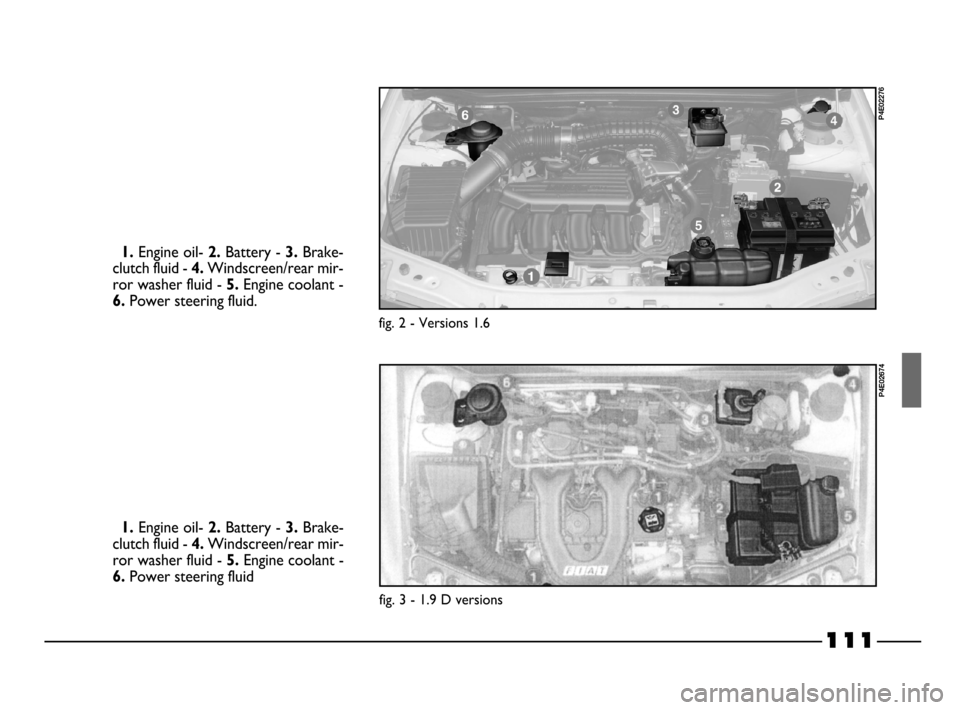
111
fig. 3 - 1.9 D versions
P4E02674
1.Engine oil- 2.Battery -3.Brake-
clutch fluid -
4.Windscreen/rear mir-
ror washer fluid -
5. Engine coolant -
6.Power steering fluid.
fig. 2 - Versions 1.6
P4E02276
1.Engine oil- 2.Battery -3.Brake-
clutch fluid -
4.Windscreen/rear mir-
ror washer fluid -
5. Engine coolant -
6.Power steering fluid
104-127 03/03/2003 06:53 PM Page 111
Page 115 of 156
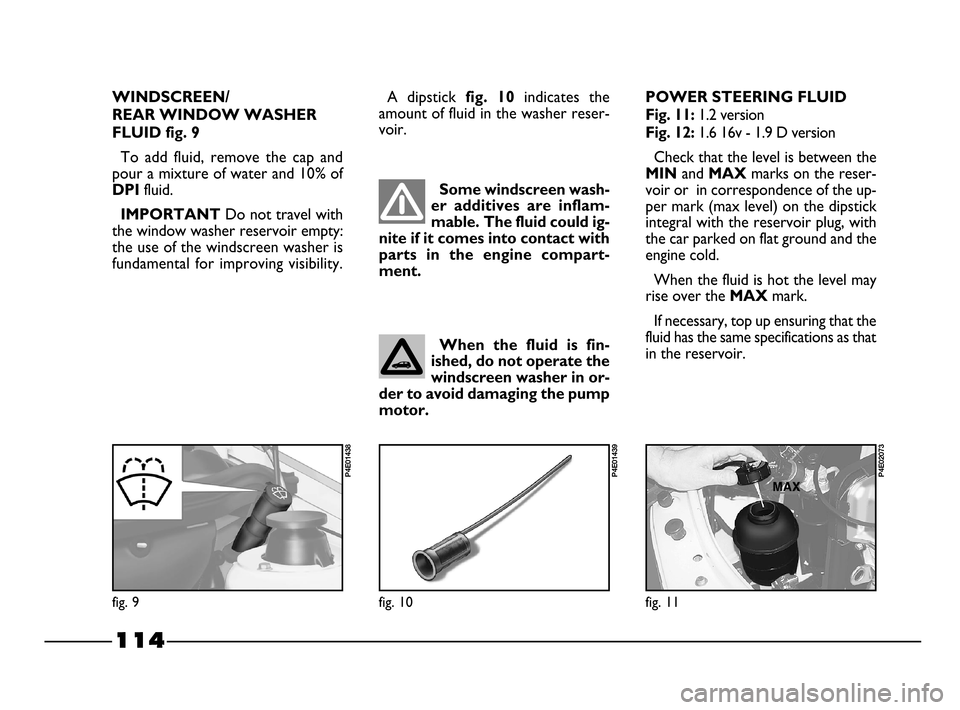
114
WINDSCREEN/
REAR WINDOW WASHER
FLUID fig. 9
To add fluid, remove the cap and
pour a mixture of water and 10% of
DPI fluid.
IMPORTANT Do not travel with
the window washer reservoir empty:
the use of the windscreen washer is
fundamental for improving visibility.
fig. 9
P4E01438
fig. 10
P4E01439
Some windscreen wash-
er additives are inflam-
mable. The fluid could ig-
nite if it comes into contact with
parts in the engine compart-
ment.
A dipstick fig. 10 indicates the
amount of fluid in the washer reser-
voir.
When the fluid is fin-
ished, do not operate the
windscreen washer in or-
der to avoid damaging the pump
motor.
fig. 11
P4E02073
POWER STEERING FLUID
Fig. 11:
1.2 version
Fig. 12: 1.6 16v - 1.9 D version
Check that the level is between the
MINand MAXmarks on the reser-
voir or in correspondence of the up-
per mark (max level) on the dipstick
integral with the reservoir plug, with
the car parked on flat ground and the
engine cold.
When the fluid is hot the level may
rise over the
MAX mark.
If necessary, top up ensuring that the
fluid has the same specifications as that
in the reservoir.
104-127 03/03/2003 06:53 PM Page 114
Page 116 of 156
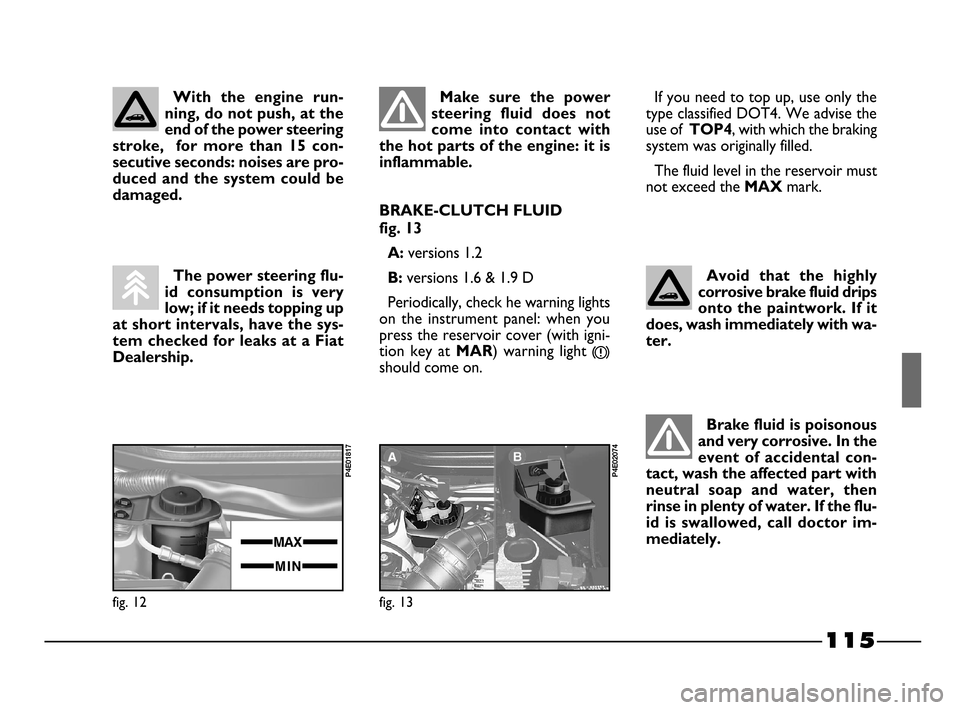
115
Avoid that the highly
corrosive brake fluid drips
onto the paintwork. If it
does, wash immediately with wa-
ter.
fig. 13
P4E02074
With the engine run-
ning, do not push, at the
end of the power steering
stroke, for more than 15 con-
secutive seconds: noises are pro-
duced and the system could be
damaged.
The power steering flu-
id consumption is very
low; if it needs topping up
at short intervals, have the sys-
tem checked for leaks at a Fiat
Dealership.Make sure the power
steering fluid does not
come into contact with
the hot parts of the engine: it is
inflammable.
BRAKE-CLUTCH FLUID
fig. 13
A:
versions 1.2
B: versions 1.6 & 1.9 D
Periodically, check he warning lights
on the instrument panel: when you
press the reservoir cover (with igni-
tion key at
MAR) warning light
x
should come on.
Brake fluid is poisonous
and very corrosive. In the
event of accidental con-
tact, wash the affected part with
neutral soap and water, then
rinse in plenty of water. If the flu-
id is swallowed, call doctor im-
mediately.
If you need to top up, use only the
type classified DOT4. We advise the
use of
TOP4, with which the braking
system was originally filled.
The fluid level in the reservoir must
not exceed the
MAX mark.
fig. 12
P4E01817
104-127 03/03/2003 06:53 PM Page 115
Page 123 of 156
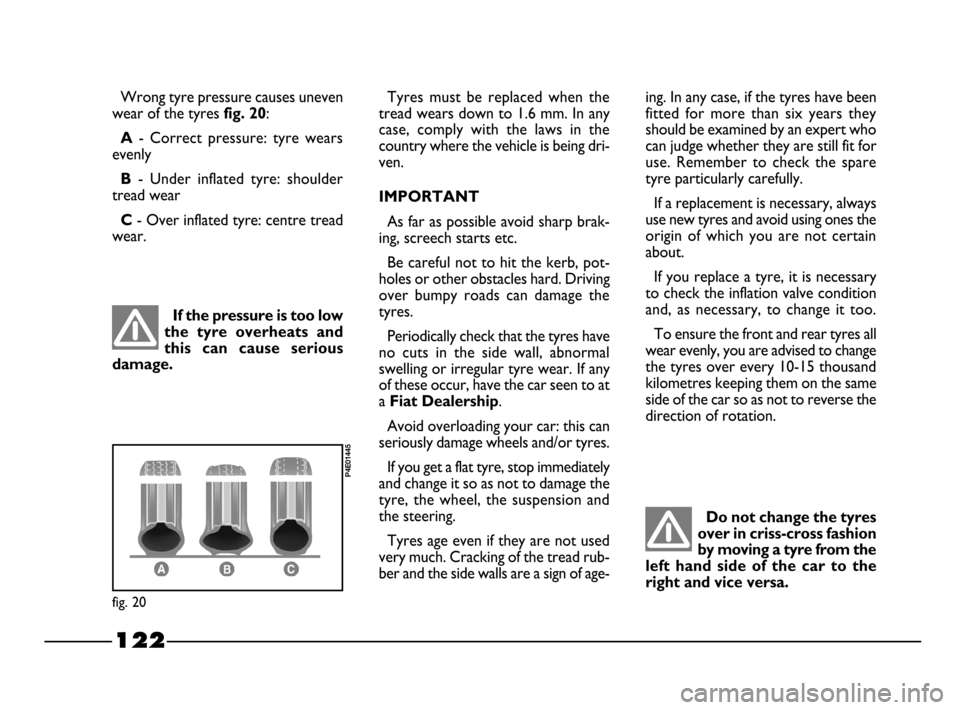
122
Do not change the tyres
over in criss-cross fashion
by moving a tyre from the
left hand side of the car to the
right and vice versa.
Wrong tyre pressure causes uneven
wear of the tyres
fig. 20:
A- Correct pressure: tyre wears
evenly
B- Under inflated tyre: shoulder
tread wear
C- Over inflated tyre: centre tread
wear. Tyres must be replaced when the
tread wears down to 1.6 mm. In any
case, comply with the laws in the
country where the vehicle is being dri-
ven.
IMPORTANT
As far as possible avoid sharp brak-
ing, screech starts etc.
Be careful not to hit the kerb, pot-
holes or other obstacles hard. Driving
over bumpy roads can damage the
tyres.
Periodically check that the tyres have
no cuts in the side wall, abnormal
swelling or irregular tyre wear. If any
of these occur, have the car seen to at
a
Fiat Dealership.
Avoid overloading your car: this can
seriously damage wheels and/or tyres.
If you get a flat tyre, stop immediately
and change it so as not to damage the
tyre, the wheel, the suspension and
the steering.
Tyres age even if they are not used
very much. Cracking of the tread rub-
ber and the side walls are a sign of age-
If the pressure is too low
the tyre overheats and
this can cause serious
damage.
fig. 20
P4E01445
ing. In any case, if the tyres have been
fitted for more than six years they
should be examined by an expert who
can judge whether they are still fit for
use. Remember to check the spare
tyre particularly carefully.
If a replacement is necessary, always
use new tyres and avoid using ones the
origin of which you are not certain
about.
If you replace a tyre, it is necessary
to check the inflation valve condition
and, as necessary, to change it too.
To ensure the front and rear tyres all
wear evenly, you are advised to change
the tyres over every 10-15 thousand
kilometres keeping them on the same
side of the car so as not to reverse the
direction of rotation.
104-127 03/03/2003 06:53 PM Page 122
Page 124 of 156
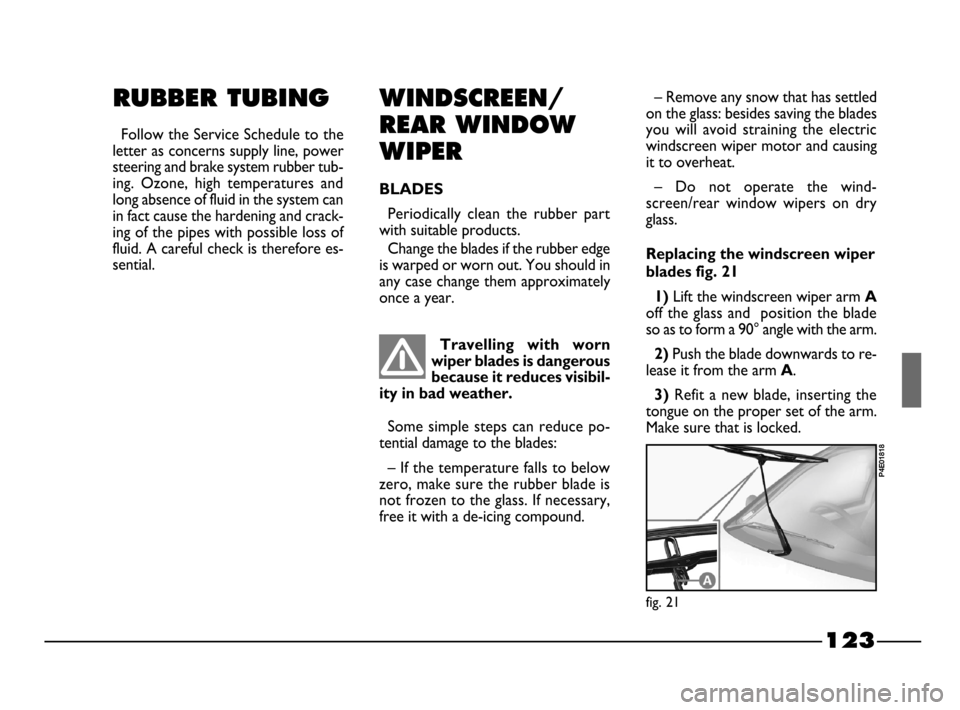
123
RUBBER TUBING
Follow the Service Schedule to the
letter as concerns supply line, power
steering and brake system rubber tub-
ing. Ozone, high temperatures and
long absence of fluid in the system can
in fact cause the hardening and crack-
ing of the pipes with possible loss of
fluid. A careful check is therefore es-
sential.
WINDSCREEN/
REAR WINDOW
WIPER
BLADES
Periodically clean the rubber part
with suitable products.
Change the blades if the rubber edge
is warped or worn out. You should in
any case change them approximately
once a year.– Remove any snow that has settled
on the glass: besides saving the blades
you will avoid straining the electric
windscreen wiper motor and causing
it to overheat.
– Do not operate the wind-
screen/rear window wipers on dry
glass.
Replacing the windscreen wiper
blades fig. 21
1)
Lift the windscreen wiper arm A
off the glass and position the blade
so as to form a 90° angle with the arm.
2) Push the blade downwards to re-
lease it from the arm
A.
3) Refit a new blade, inserting the
tongue on the proper set of the arm.
Make sure that is locked.
Travelling with worn
wiper blades is dangerous
because it reduces visibil-
ity in bad weather.
Some simple steps can reduce po-
tential damage to the blades:
– If the temperature falls to below
zero, make sure the rubber blade is
not frozen to the glass. If necessary,
free it with a de-icing compound.
fig. 21
P4E01818
104-127 03/03/2003 06:53 PM Page 123
Page 129 of 156

TECHNICAL SPECIFICATIONS
Motor and engineering enthusiasts as well as
those “in the trade” will probably start reading from
this point in the handbook. This, in fact, is where a
section jam-packed with facts, figures, formulae,
measurements and tables begins.
In a sense, it is Fiat Palio’s identity card. A docu-
ment that introduces the car and explains in techni-
cal jargon all the features that go together to make it
a model designed to give you superlative driving sat-
isfaction.CAR IDENTIFICATION DATA ........................... PAGE 129
ENGINE CODES -
BODYWORK PAINT IDENTIFICATION
PLATE .......................................................................... PAGE 130
ENGINE ....................................................................... PAGE 131
TRANSMISSION ....................................................... PAGE 133
BRAKES ....................................................................... PAGE 134
SUSPENSIONS ......................................................... PAGE. 134
STEERING ................................................................... PAGE 135
WHEELS AND TYRES ............................................ PAGE 136
ELECTRICAL SYSTEM ............................................ PAGE 137
WEIGHTS ................................................................... PAGE 138
PERFORMANCES ..................................................... PAGE 138
DIMENSIONS ............................................................ PAGE 139
CAPACITIES .............................................................. PAGE 140
FLUIDS AND LUBRICANTS ................................. PAGE 141
TYRE PRESSURE ....................................................... PAGE 143
128
128-143 03/03/2003 07:39 PM Page 128
Page 136 of 156
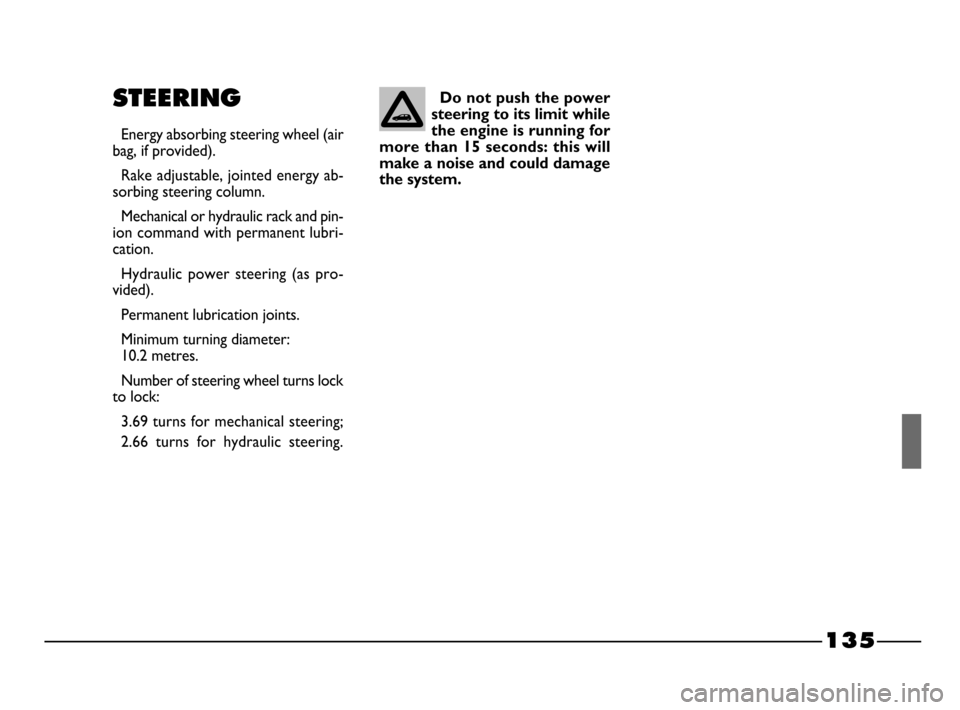
135
STEERING
Energy absorbing steering wheel (air
bag, if provided).
Rake adjustable, jointed energy ab-
sorbing steering column.
Mechanical or hydraulic rack and pin-
ion command with permanent lubri-
cation.
Hydraulic power steering (as pro-
vided).
Permanent lubrication joints.
Minimum turning diameter:
10.2 metres.
Number of steering wheel turns lock
to lock:
3.69 turns for mechanical steering;
2.66 turns for hydraulic steering.
Do not push the power
steering to its limit while
the engine is running for
more than 15 seconds: this will
make a noise and could damage
the system.
128-143 03/03/2003 07:39 PM Page 135
Page 137 of 156

136
Max speed index
Q
= up to 160 km/h.
R= up to 170 km/h.
S= up to 180 km/h.
T= up to 190 km/h.
U= up to 200 km/h.
H= up to 210 km/h.
V= up to 240 km/h.
W= up to 270 km/h.
Y= up to 300 km/h.
Load index (capacity)
60
= 250 kg
61 = 257 kg
62= 265 kg
63= 272 kg
64= 280 kg
65= 290 kg
66= 300 kg
67= 307 kg
68= 315 kg
69= 325 kg
70 = 335 kg
71= 345 kg
72= 355 kg
73= 365 kg
74= 375 kg
75= 387 kg
76= 400 kg
77= 412 kg
78= 425 kg
79= 437 kg
80= 450 kg
81= 462 kg
82= 475 kg
83= 487 kg
84= 500 kg
85= 515 kg
86= 530 kg
87= 545 kg
88= 560 kg
89= 580 kg
90= 600 kg
91= 615 kg
92= 630 kg
93= 650 kg
94= 670 kg
95= 690 kg
96 = 710 kg
97= 730 kg
98= 750 kg
99= 775 kg
100= 800 kg
101= 825 kg
102= 850 kg
103= 875 kg
104= 900 kg
1CORRECT READING
OF THE RIM fig. 6
The indications, necessary to know
the meaning of the identification ini-
tials printed on the rim, are listed be-
low.
CORRECT READING
OF THE TYRE fig. 6
The indications, necessary to know
the meaning of the identification ini-
tials printed on the tyre, are listed be-
low.
175= Nominal (S, distance in mm
between the sides).
65= height/width ratio (H/S) in per-
centage.
R= Radial tyre.
14= Diameter of the rim in inches
(Ø).
82= Load index (capacity).
T= Max speed index. Example
175/65 R 14 82 S
IMPORTANTThe light alloy
wheels are fixed with specific bolt in-
compatible with any printed steel
wheels, excluding the specific spare
wheel.
SNOW TYRES
Use reduced dimension winter tyres,
see “Snow Chains” chapter.
WHEEL GEOMETRY
Convergence of the front wheel mea-
sured between the rims: –1±1(Power
Steering), +1mm (Mechnical Steering).
The values refer to a car after running in.
WHEELS AND
TYRES
Pressed steel or alloy (as provided)
wheel rims; specific fixing bolts (di-
mensionally different and respective-
ly incompatible) for each of the two
types of rim.
IMPORTANTIn the event of dis-
crepancies between the information in
the Owner Handbook and the Log
Book, consider the specifications giv-
en in the Log Book only.
To ensure safety of the vehicle in
movement, it must be fitted with tyres
of specified size and of the same make
and type on all wheels.
Versions Rim Tyre
1.2 EL-ELX-SPORT5.00Bx13 165/80 R13
1.6 16V GTX51/2 Jx14C(*) 175/65 R14
1.9 D EL-ELX5.00Bx13 165/80 R13
(*) Alloy rims
128-143 03/03/2003 07:39 PM Page 136
Page 141 of 156

1.2
litres kg
47 –
5.5-7.5 –
5.9 6.1
3.05 2.75
1.8 1.5
0.68 0.54
– 0.075
0.40
0.50
2.3 –
1.6
litre kg
47 –
5.5-7.5 –
6.6 6.8
3.88 3.5
1.8 1.5
0.68 0.54
– 0.075
0.40
0.50
2.3 –
140
Prescribed fuels
Recommended products
Super unleaded petrol 87 R.O.N.
Mixture composed by 70% distilled water
and 30% fluid
PARAFLU11
VS MAX PETROL(*)
ZC 80/S
GI/A
MRM 2
TOP 4
TOP 4
Mixture of distilled water and 10% of fluid DPI
CAPACITIES
(*) Do not top up with oil having specifications different from the oil present in the car.
47 –
5.5-7.5 –
4.8 3.9
43.3
2.0 1.73
0.68 0.54
– 0.075
0.40 –
0.50
2.3 –
1.9
litre kg
Fuel tank:
including a reserve of:
Engine cooling system:
– with manual climate control system
ngine sump:
Engine sump and filter:
Transaxle:
Hydraulic power steering:
CV joint cavities and boots :
Front and rear hydraulic brake circuit:
Hydraulic brake circuit with
ABS antilock device:
Windscreen/rear window washer
fluid reservoir:
128-143 03/03/2003 07:39 PM Page 140